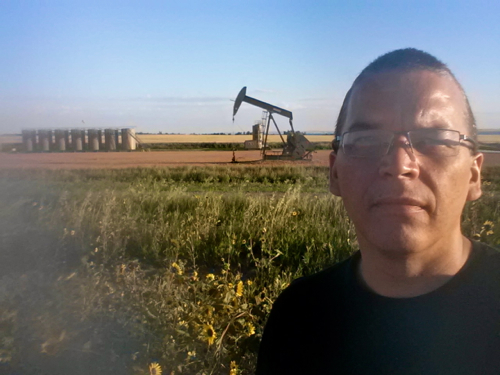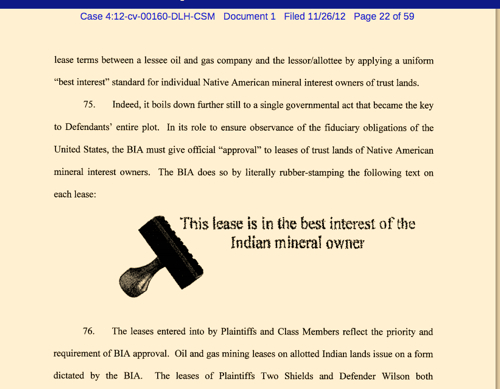"To keep the connection between the Indian person and the land -- which is being severed by so many things." -- Marilyn Hudson
Frank Jr. Molley of Honor the Earth and I had an appointment to meet with Marilyn Hudson and discuss the work of the Land Owner's Association of Fort Berthold, and we were late. Negotiating construction, heavy-load trucks, dust, potholes, stones kicked up by speeding trucks, mesmerizing gas flares and ruts that looked like miniature gorges slowed us down considerably as we drove west on Highway 23 to the peaceful, little community of Parshall, North Dakota. Located just south of the highway, Parshall is within the boundaries of the Fort Berthold Indian Reservation -- home to the Three Affiliated Tribes of the Mandan, Hidatsa and Arikara Nations. It was obvious that the use of horizontal drilling and hydraulic fracturing to tap into the massive Bakken Oil Formation had unleashed a maelstrom of unstoppable, damaging and unpredictable industrial development.

Frank Jr. Molley of Honor the Earth. Credit: Frank Molley
Three years ago estimates indicated 577 billion barrels of oil were under the Bakken Formation, and Fort Berthold is considered the "sweet spot" for oil extraction. Since the implementation of a number of new test wells, estimates have been revised to 903 billion barrels of oil, an increase of 57 percent in less than three years.
After several cell phone conversations directing us to her modest bungalow, Marilyn greeted us at the door and asked us to join her at the kitchen table. At 77 years and counting, Marilyn does not appear to be slowing down at all. The Mickey Mouse watch strapped to her left wrist was an affirmation of her quirky sense of humor and an open personality that was trusting of the strangers she invited into her home.
Marilyn Hudson's father was full-blooded Hidatsa/Mandan and her mother was Norwegian. Marilyn has lived in the area for most of her 77 years. Her passion at this stage of her life, after working for the Bureau of Indian Affairs, and now as an administrator at the Museum of the Three Affiliated Tribes, is establishing an online database that will keep tribal members informed about the impact of oil exploration on the reservation.
"The history of the oil boom and our tribal histories reflect good and bad decisions," she said. "The poor decisions will haunt our tribe for the rest of its existence."
Haunted by Decisions
Fort Berthold has good reason to be haunted by recent decisions that were made by the tribal government, as well as those that were historically forced upon the people by the government of the United States.
Fort Berthold Reservation is located in western North Dakota and today encompasses about one million acres -- a fraction of its ancestral range. The beautiful Missouri River Valley has been home to this agricultural people for hundreds of years. As a result, religious and spiritual ties to the land and sacred sites run strong. In the December 2011 issue of the North Dakota Law Review, Raymond Cross discusses the social and environmental needs of the Three Affiliated Tribes as Fort Berthold faces unprecedented challenges during the boom. Will the reservation become development's victim or its beneficiary? Cross concludes that oil and gas development must be subjected to "reasonable legal and social regulation."
The original territorial lands of the Three Affiliated Tribes included an area reaching from east of the Missouri River to Montana, and south to what is now Nebraska and Wyoming. The Fort Laramie Treaty of 1851 established the size of the reservation from about 12 to 13.5 million acres, and subsequent acts of Congress reduced Fort Berthold to about 930,000 acres, which now also includes "white-owned land."
Lake Sakakawea covers 155,000 acres of reservation land, and "covers" is the operative word. The Garrison Dam Project flooded the bottomlands of the Missouri River and completely obliterated many of the long-established Indian population centers of the Fort Berthold Reservation. Before the reservoir was built, 289 out of 357 households were located in the reservoir area. The current resident Indian population of the Reservation is approximately 3,776, with an enrolled population of 9,500. Many moved away after the "takings" of the Garrison Dam Project destroyed culture, fertile growing lands and a sense of place.
History records that the then residing Three Affiliated Tribes council chair, George Gillette, was coerced into signing off on the takings of the Garrison Dam Project. Gillette wept uncontrollably as he signed the coerced agreement.

George Gillette (left), chairman of the Fort Berthold Indian Tribal Business Council, weeps as Secretary of Interior J.A. Krug signs a contract whereby the tribe sells 155,000 acres of its reservation in North Dakota for the Garrison Dam and Reservoir project, 1948. (Government Photo)
As noted by Cultural Survival here:
The Three Affiliated Tribes drew up a contract in 1948 for approval. Indians feared that if they failed to consent to outlined terms, they would receive less adequate compensation in the future. In tears, Council Chairman George Gillette 'consented' to the coercive piece of legislation. 'The truth is, as everyone knows,' he said, 'our Treaty of Fort Laramie... and our constitution are being torn to shreds by this contract.'
There were nine communities lost to the flooding of the Garrison Dam. These communities had a sawmill, schools, a hospital, government buildings, churches, community playgrounds parks and cemeteries. Today, outside interests want the oil, just as they had historically coveted the land for the westward expansion of Manifest Destiny.
Tribal Data Base
Marilyn Hudson wants to establish an online database of anything and everything that the Bakken Oil boom brings to the reservation so that tribal members know more about what their representatives on the Tribal Council are doing. She would also like to see more access to data on health and education issues. The community college is under threat of losing its accreditation, roads are a mess, people are sick and the tribe takes in over $8 million a month from oil leases. A 2011 reservation audit charged that there was corruption, nepotism and "ethical violations and/or criminal activity" among the tribal officials who arranged sweet oil deals.
As noted here:
In 2011 a team of elders audited the tribal council's activities. They found widespread financial inconsistencies that they said indicated systemic misconduct. 'We saw millions of dollars going out and hardly anything coming back,' to the Three Affiliated Tribes, said Tony Foote, a forensic auditor who chaired the team. 'We're not just talking about cash. It's rooms, food, travel, donations and there's only a handful of people that can get all this stuff.'
But who was responsible? Was the U.S.A. culpable for not exercising its duty as caretaker of the "sovereign nation" of Fort Berthold?
Are the Tribes a Sovereign Nation or is the U.S.A. King ?
In November 2012, a Class Action Complaint filed in the U.S. District Court of North Dakota by Ramona Two Shields and Mary Louise Defender Wilson (Case 4:12-cv-00160-DLH-CSM) accused tribal middlemen and others of a lease swindle that flipped 42,000 Indian Trust Land acres of mineral interest acquired at well below market prices. The Trust Land was sold for a paltry $50 an acre to an entity known as Dakota-3, which subsequently sold the drilling rights to Williams Companies for an eventual $925 million. Dakota-3 was a shell company, set up with no value for the sole purpose of purchasing and flipping leases.
Two players who were working for the reservation allegedly organized the swindle. The Four Bears Casino manager had access to casino funds for influence and also served on the board of directors for the tribal-owned Fort Berthold Development Corporation (FBDC).
85,000 acres of tribal and allottee mineral leases on the Fort Berthold Reservation eventually changed hands. The payoff in the final flip was $10,000 per acre and, "not the $110 per acre lease bonus that most individual Native American mineral interest owners were paid," according to the complaint. The "Two Shields" case is still alive and will be argued on Sept 20, 2013 by all parties, including an "Amicus" argument by the U.S. government, in U.S. District Court in Bismarck. "Amicus," means a party not directly involved, but considered a friend of the court.
Two Shields vs. BIA Rubber Stamp

Image: Screen shot
In a separate case in Federal Court (Case #1:11-cv-00531-LB), filed in August 2011, Two Shields and Wilson sued the U.S.A. for $400,000, "alleged(ing) that the United States mismanaged their non-monetary trust assets, namely that the United States breached its fiduciary obligations to Plaintiffs by entering into certain oil and gas leases on allotted land within the Fort Berthold Indian Reservation between 2006 and 2009."
The plaintiffs had not opted out of a similar class action suit that was eventually settled in December of 2012. 400,000 Native Americans from numerous tribal groups received $1,000 checks. The Two Shields Federal case was dismissed.
On August 1, 2013, the Claims Administrator mailed letters detailing its second determination of eligibility to all persons who filed a request for reconsideration in Cobell v. Salazar. See this website for updates on the trust fund.
Doing Things in the Right Manner
"Our organization is not pro-development nor are they anti-development. But they are for doing things in a right manner," Marilyn said as we studied several court documents with her. "So many of our regulations are being wiped away in this rush to harvest the oil."
The tribe has an environmental code, but social media sites on the reservation detail incident after incident of anecdotal violations by the oil companies.
Marilyn hopes the web-based database will list events, remediation and enforcement.
